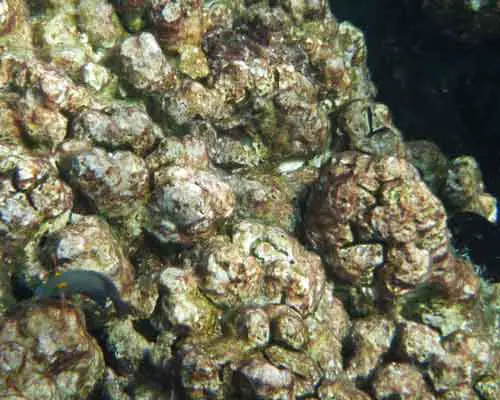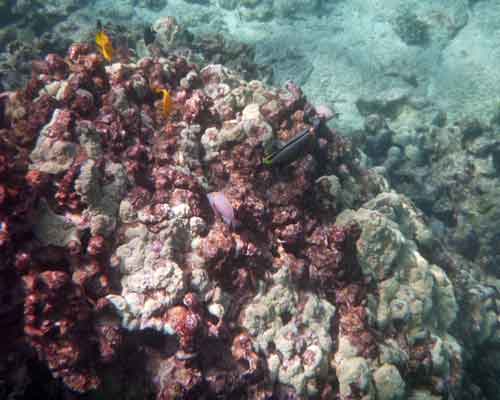The first time I read the term live rock used in the context of a saltwater aquarium, my head exploded. How, in the world, could rock be alive, and what does it need to be cured from?
To cure live rock, store it in salt water free from fish, corals & invertebrates for 2-4 weeks. This allows toxic ammonia released from decaying organisms on the rock to be converted into nitrates in a safe way. The rock is considered cured once ammonia in the water is undetectable.
Live rock is one of the most important things you will add to your saltwater aquarium. It serves as both the structural and filtration-al… (I never miss an opportunity to make up a new word) foundation of most saltwater aquarium systems. Live rock also provides an important source of biological interest and diversity? Don’t believe me? Just take a look–a close look–live rock is awesome. But if you add live rock to your aquarium improperly–you could be asking for trouble.

What is live rock?
A healthy coral reef is teeming with life. Even the areas around the reef that are not colonized by proper corals have tons of other marine life living on their surfaces–bacteria, sponges, algae, and of course…worms…
Live rock is the term used for those pieces of rock that have broken away from the main reef. This happens naturally from storms or waves–and these days, live rock is even aquacultured, meaning it is ‘grown’ like a crop and harvested specifically for our use.
Where does it come from?
I’m not sure if this is an official statement or just officially my observation and opinion at the time, but the most common live rock I see around here (Philadelphia area) is live rock from Fiji. Some of the aquacultured varieties are grown in the Gulf or Caribbean regions in and around the U.S., but the important thing, from my perspective, is that the live rock, which was teeming with life in the water, was packed up and shipped across the country or across the world to you–and that has the potential to cause problems.

Why cure live rock?
During the transportation and handling of the live rock–many of the organisms will die. Some of them will slowly die…as in…rot away…and you don’t want that to happen in your aquarium. So we cure live rock, in order to allow the natural die-off, while also maximizing the amount of life you keep on the live rock–after all–that marine life is exactly why you paid such a handsome price for the rock in the first place.
How much live rock do you need?
Well, that’s the topic of another blog post you can find here.
How to remove unwanted pests
I picked this tip of from Liveaquaria.com–but some of the most troubling pests that can hitchhike their way into your tank are mantis shrimp and other larger predatory invertebrates, like crabs, etc, or even not-so-dangerous, but extremely unpopular pests, like hair algae, bryopsis algae, aiptasia anemones, and bristle worms.
Read all about live rock hitchhikers here.
The method they provide to remove those pests from the live rock is to submerge the rock in a bucket of saltwater. The rock has been out of water for some time–the inverts inside it are pretty spooked. If you are lucky, you may find that the pests will take that opportunity to dart out of their previous home to find refuge someplace else, hopefully, more consistently wet. That place you’ve provided is the bottom of the bucket.
Let me know if this method has worked for you.
How to cure live rock: A simple step-by-step guide
Now the event you’ve all been waiting for–the secret to how to cure live rock: You put it in some saltwater and wait :). Okay, it’s not quite that simple, but here’s the deal. You want to put the rock in an environment where it can be completely submerged in aquarium-quality water for a period of 2-4 weeks (you will use test kits to determine exactly when the rocks are ready).

Equipment list:
- Bucket, trash can or empty aquarium
- Heater
- Air pump with airline or powerhead
- Ammonia, Nitrite and Nitrate test kits
Heat the saltwater in your container up to about 78-82 degrees Fahrenheit and place the rocks in. I prefer to use a glass aquarium because I want to look at the rock while it is curing, to identify anything that is dying, so it can be removed/scrubbed off. It’s harder to see things when you take the rock out of the water. Arrange the airline or powerhead to provide a nice flow of water over and through the rocks.
Test the water, periodically, to confirm an expected spike in ammonia, then a spike in nitrites followed by nitrates that are expected when dealing with decay in a tank without a sufficient biological filter. Perform a water change every week if you see the levels getting high–remember, you want to keep the good stuff alive–while allowing for the bad stuff to die. The more you care about your rock and the life on it–the more you should test and do water changes. The more you think…well…it’s a rock…the lazier you can afford to be because you don’t care.
Look for dying stuff on the rocks–and scrub that stuff off with a toothbrush (preferably not your own) and put the rock back in the water. Here’s a link to buy a new toothbrush so you don’t have to use yours ;).
You can pat yourself on the back for curing your live rock when you test the water two tests in a row (a couple days apart) and detect no ammonia and no nitrites. It is normal, healthy, and good to detect nitrates.
This whole process should take about 2-3 weeks.
Do one final, rigorous inspection to make sure you don’t have anything pesty growing on the tanks that you’ll wish you hadn’t introduced and you’re ready to graduate your live rock
For more information
Check out a few other important articles about live rock:
The definitive guide to live rock
Curing live rock can really be that simple, but if you want to dive a bit deeper into the topic, I recommend you check out this video comparing the best methods for curing live rock, made by BRS.


Leave a Reply